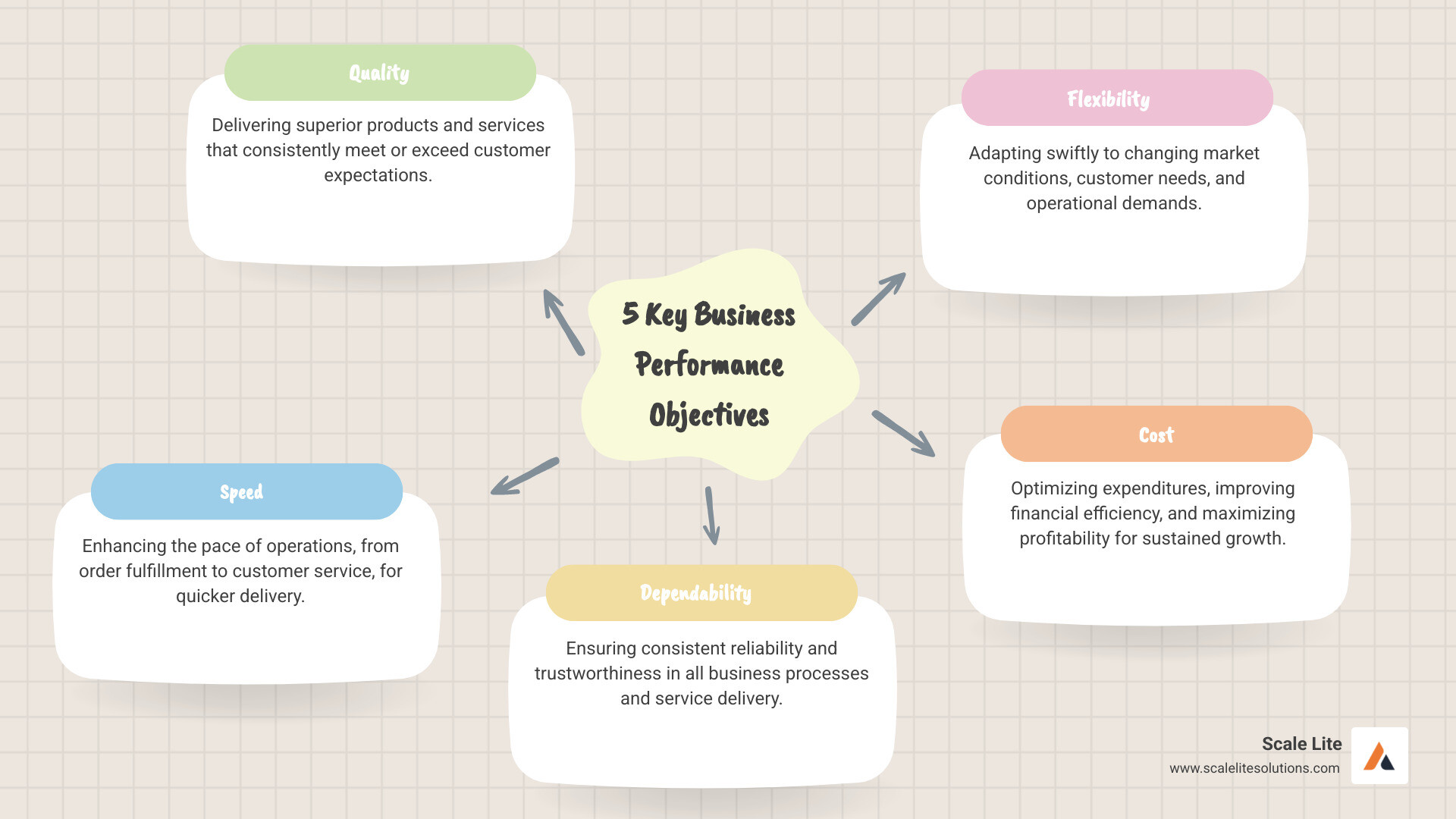
Performance Power-Up—How to Enhance Your Business Operations

Why Enhancing Business Performance Matters
Learning How to improve business performance? is a universal goal for owners wanting a stronger, more efficient, and profitable company. It’s not about being a tech or finance wizard; it's about finding smarter ways to work.
To get started, here are key areas to focus on:
- Operational Efficiency: Streamline processes to do more with less effort.
- Financial Health: Actively manage costs, cash flow, and profitability.
- People & Culture: Engage, develop, and empower your team.
- Customer Focus: Prioritize satisfaction and build lasting relationships.
- Strategic Technology: Leverage the right tools for automation and data insights.
Improving business performance isn't just a fancy phrase—it means real results like sustained growth, higher profits, and a stronger competitive edge. For service businesses, it also means reducing owner dependence and building a company that thrives independently. The tangible benefits include revenue growth, optimized costs, happier customers, and a higher overall business value.
As Keaton Kay, I've spent years helping service-based businesses like yours transform their operations with practical, scalable systems. My background in private equity, enterprise software, and automation helps owners build more valuable, less owner-dependent companies.

Terms related to How to improve business performance?:
Laying the Foundation: Assess Your Current Performance
To improve business performance, you first need to know where you stand. A clear assessment is the crucial first step, allowing you to pinpoint strengths and weaknesses. This enables smart, data-driven decisions instead of guesswork.

Getting this clear picture requires a holistic view of your entire operation, not just a glance at your bank balance. Here are some powerful tools:
A SWOT analysis helps you look inward to identify your internal Strengths and Weaknesses, and outward to spot external Opportunities and Threats. For example, a strength might be your skilled technicians, while a weakness could be an aging fleet of vans. An opportunity could be a boom in smart home installations, while a threat is a new competitor. A SWOT analysis helps you align your efforts strategically.
Benchmarking is seeing how you measure up against the best in your industry. Are your service calls faster? Is your customer satisfaction higher? Benchmarking gives you a clear standing and helps you set realistic, ambitious goals.
Process mapping involves drawing a map of how work gets done. By visualizing each step, you can quickly spot bottlenecks, redundancies, or inefficiencies. For example, mapping your dispatch process might reveal that manual data entry slows things down and delays service calls.
At the heart of assessment is tracking your Key Performance Indicators (KPIs). These are the essential numbers that tell you if you’re hitting your goals. KPIs generally fall into a few key categories:
- Financial metrics: These numbers directly impact your bottom line, including revenue growth, profit margins, and cash flow. As a NetSuite article highlights, understanding financial performance is crucial for measuring success, making smart decisions, and securing funding.
- Operational metrics: These show how efficient your day-to-day operations are. For a service business, this could include your first-time fix rate, average job completion time, or inventory turnover.
- Customer metrics: These show how well you’re serving clients. Important ones include customer satisfaction scores (CSAT), Net Promoter Score (NPS), and customer retention rates.
- Employee metrics: These help you understand your team's health and productivity, including employee engagement scores, turnover rates, and team productivity.
It’s important to look at these financial performance indicators together. High revenue is great, but if costs are also high, your profit margins might be shrinking. Always compare current numbers with past performance and industry benchmarks to get the full picture.
Analyzing this data provides powerful insights, forming a solid foundation for targeted strategies that will move the needle for your business. And speaking of data, you can dive into More info about Data-Driven Decision Making.
How to Improve Business Performance with Strategic Methodologies
This section explores the three core pillars for boosting your business: your people, your processes, and your technology. By focusing on these areas, you can create a powerful, synergistic effect that drives sustainable growth and profitability.
How to Improve Business Performance by Empowering Your People
Your people are the heart of your business. Without a motivated and skilled team, strategies fail, especially in service businesses where technicians define your reputation.
Employee engagement is a critical driver of success. Engaged employees are more productive, innovative, and loyal. According to a Gallup study, they can increase profitability by 21%. Achievers' research also found that culture alignment is a key way to increase an employee’s emotional salary.
A strong company culture fosters collaboration. Organizational performance expert Michael Taylor notes a significant "perception gap" between leaders and implementers. In one case, leaders saw five roadblocks to a decision, while implementers saw 44. This highlights the need for open communication and involving teams in decisions.
Talent development is also crucial. Investing in your team's growth through training, certifications, and cross-training makes them more skilled and signals that you value them. As the article "How to improve your organization’s performance" states, you need to provide your team with the business skills to stay competitive, including training for current and future roles.
Finally, employee recognition plays a huge role. Acknowledge hard work and celebrate successes. An Achievers article notes that online recognition platforms are twice as effective as in-house programs. Even a simple "thank you" goes a long way. As the journal article "Maximize Business Achievement" suggests, recognition doesn't always have to be monetary. Workforce surveys even suggest people believe they could improve performance by 15-20% if they felt their improvements would be recognized.
When your people feel appreciated and connected, they become powerful advocates for your business. To dive deeper, you can Learn more about effective employee recognition and find More info about how to Improve Business Operations.
How to Improve Business Performance by Streamlining Your Processes
Efficient processes are the backbone of your operations, ensuring your business runs smoothly and profitably. This is the core of operational excellence.

At the heart of this is Lean management principles, which focus on eliminating waste. The eight common types of waste are:
- Transportation and travel: Unnecessary movement of materials or people.
- Motions and actions: Unnecessary movements by employees.
- Waiting: Downtime for people or equipment.
- Overproduction: Producing more than is needed.
- Inventory: Excess stock or materials.
- Overprocessing: Doing more work than required.
- Defects and errors: Mistakes requiring rework.
- Underused talent: Not using employees' full skills.
Applying methods like 5S (Sort, Set in order, Shine, Standardize, Sustain) boosts efficiency. For example, one manufacturer doubled vehicle production with the same resources just by streamlining processes. The article "Strategies for Optimizing Your Company’s Performance" notes that a company could improve production by over 20% without adding staff or equipment through better optimization.
Cost optimization means smart financial management, not cutting corners. Monitor cash flow regularly. As the NetSuite article highlights, strong financial performance is key to measuring success and making informed decisions. Also, focus on smart pricing strategies to ensure you aren't serving unprofitable clients—some companies find that 34% of their clients are unprofitable.
Tax compliance is another critical area. Missing tax deadlines is costly, with penalties up to 25% of unpaid taxes. Meeting deadlines avoids these fees and maintains your business's good standing.
Effective inventory management is vital. Ensure you have the right parts without tying up capital in excess stock. Use techniques like ABC analysis to prioritize high-value items (Class A). Offer markdowns on surplus stock to free up cash.
By refining your processes, you can eliminate waste, reduce costs, and improve efficiency. For an in-depth look, watch our Lean your business webinar and explore More info about Business Process Streamlining.
Leverage Technology: Your Unfair Advantage
Technology is a powerful performance multiplier, not just a convenience. For service businesses, the right tech provides a competitive advantage, allowing you to focus on delivering exceptional service.
Automation is a game-changer. Automating repetitive tasks like scheduling and invoicing frees up your team for higher-value activities. As a KPMG study revealed, process automation is a top strategy, cited by nine out of ten surveyed managers.
Real-time data gathering is another superpower. Modern tech allows for instant data collection on everything from job times to customer feedback, enabling quick, informed decisions instead of waiting for monthly reports.
Customer Relationship Management (CRM) systems are essential for tracking customer interactions, managing leads, and providing personalized service by keeping all customer data in one place. This is vital, as 89% of people would likely patronize a business that personally answers reviews.
For blue-collar services, smart tools offer incredible benefits, including:
- Route optimization software: Minimizes travel time and fuel costs.
- Predictive maintenance sensors: Alert you to potential equipment issues before they become costly breakdowns.
- Mobile field service apps: Empower technicians with job details, customer history, and inventory on the go.
Investing in technology also helps address labor shortages by making jobs more appealing. As the "Strategies for Optimizing Your Company’s Performance" article points out, Industry 5.0 emphasizes the interaction between digital technologies and employees.
By strategically deploying technology, you drive enterprise value. We believe that Purpose-built technology can provide clarity and control and offer More info about Technology Management.
A 5-Step Implementation Plan for Lasting Change
Improving business performance is a journey, not a finish line. To ensure lasting improvements, you need a clear roadmap. This systematic approach helps you steer challenges and achieve your goals.

Here’s our proven 5-step implementation plan to guide you:
Define Clear Goals: First, know where you're headed by setting Clear Goals. The SMART goals framework is effective because it ensures your objectives are Specific, Measurable, Achievable, Relevant, and Time-bound. One business statistic notes that companies with more than five major goals struggle to focus resources on any one of them. Keep your major goals to a manageable 3-5 and involve your team in setting them.
Create a Detailed Plan: With goals set, Create a Detailed Plan. This strategic plan is a map for your team, outlining actions, timelines, responsibilities, and needed resources. It translates your big objectives into clear, actionable steps for everyone. The plan should be detailed but flexible enough to adapt to shifting priorities.
Empower the Right People: A great plan needs great people. Empower the Right People by matching the right skills to the right tasks. Focus on building a supportive culture and hiring people who are eager to grow. Ensure your team knows their roles and has the resources and training to succeed. When employees feel involved and valued, they can truly use their talents.
Monitor, Measure, and Adjust: Keep your finger on the pulse by regularly checking progress against your KPIs. As the "Maximize Business Achievement" article asks, can you picture a sports team playing without a scoreboard? It's just as vital in business for tracking performance. Use tools like SIPOC (Suppliers, Inputs, Process, Outputs, Customers) and process mapping to visualize and improve workflows. If something isn't working, fine-tune your approach. This continuous feedback loop is essential.
Foster a Culture of Continuous Improvement: Improving performance is an ongoing journey. The final step is to Foster a Culture of Continuous Improvement. Empower everyone to spot areas for growth and suggest solutions. This requires clear communication, celebrating wins, and learning from setbacks. As one article wisely suggests, we should "evaluate failure with new eyes" as a chance to evolve. By weaving improvement into your company's DNA, you ensure it stays agile and competitive. This commitment is a core part of our Business Growth Strategy.
The Tangible Rewards: What Success Looks Like
Enhancing business performance delivers tangible benefits across your company. Committing to this journey creates a cascade of positive outcomes that drive you forward.
First, you'll see increased profitability. Streamlining operations, managing costs, and boosting efficiency directly improve your bottom line. This increased profitability gives you the freedom to reinvest in growth, develop your team, or enjoy a healthier financial position. For example, a Total Economic Impact Study showed one solution delivered $24.5 million in benefits for service organizations, highlighting the potential financial gain.
Next comes improved customer satisfaction. When your operations are smooth and your team is engaged, customers notice. This translates to faster service, higher quality work, and better communication, leading to delighted clients who become repeat customers and refer others.
Another outcome is improved employee retention. When you value your people and invest in their growth, they want to stay. This reduces recruitment costs and builds an experienced, stable team.
All these improvements culminate in a higher enterprise value. A well-performing company is more attractive to investors and naturally commands a higher valuation if you plan to sell. At Scale Lite Solutions, we focus on helping clients drive this enterprise value.
Real-world examples show this works. For example, a Brisbane café saved money and reduced waste by using a commercial composting facility—a small change with a clear win. Another example is a coffee shop that used a SIPOC (Suppliers, Inputs, Process, Outputs, Customers) analysis to question its process, finding ways to boost productivity and reduce waste. These smart, targeted improvements bring tangible results. To inspire you further, you can learn about how A Queensland business saved money by tackling food waste and find More info about How to Drive Business Growth.
Frequently Asked Questions about Enhancing Business Performance
Thinking about how to improve business performance? can be overwhelming. Let's tackle some common questions.
What are the most important areas to focus on first for performance improvement?
Start with the "low-hanging fruit"—changes that deliver a big impact with minimal effort.
For many service businesses, a great first step is focusing on financial management and cost control. You can quickly spot areas where money is slipping away, like by tightening payment collection or negotiating better supplier deals. Knowing your daily running costs (OPEX) and service delivery costs (COGS) is foundational.
Another crucial area is boosting operational efficiency in your core service process. This could mean optimizing technician routes to reduce drive time or refining your scheduling system. Small tweaks to how your team completes jobs can reduce errors, speed up service, and lead to happier customers and a healthier bottom line.
How can a small, low-tech business afford to invest in technology?
Investing in technology doesn't have to be expensive. The key is to start small and focus on cloud-based tools. These are like online subscriptions, so you don't need costly equipment or a complex IT setup. They are flexible, allowing you to pay for what you use and expand as you grow. Examples include online scheduling tools, digital invoicing, or mobile apps for field technicians.
View technology as an investment, not just a cost. The Return on Investment (ROI) often comes quickly from time saved and errors avoided. An automated scheduling system, for example, can save hours of manual work each week, freeing up time to win more business. While a KPMG study noted larger companies are further ahead with AI, small businesses can achieve significant results with simpler automation and data tools.
For more ideas, you can find More info about Digital Change Strategies for Small Businesses.
How do I get my employees on board with new changes?
Employee resistance to change is natural. The key to getting buy-in is clear and constant communication.
First, explain the "why." People are more likely to accept change if they understand the purpose and how it benefits them and the business. Will it reduce tedious paperwork or make their jobs easier? Clearly state the purpose.
Second, involve them in the process. Your frontline employees often have the best ideas. Ask for their input and include them in decisions. As organizational expert Michael Taylor noted, there's often a "perception gap" between leaders and implementers. Bridge this gap by listening to your team's concerns and suggestions to ensure a smooth rollout.
Finally, ensure your company policies support efficiency rather than forcing workarounds. Open communication and showing how changes will empower your team are the keys to a successful transition.
Conclusion
Improving business performance is a dynamic and rewarding path. It requires a holistic approach that harmonizes your people, your processes, and your technology. Aligning these three pillars open ups incredible potential for growth and profitability.
We've seen how empowering your team, streamlining operations with Lean principles, and leveraging technology like AI and automation can provide a significant competitive advantage. This is a continuous journey of assessment, adaptation, and commitment. For service businesses and companies in low-tech industries, embracing these modern tools is essential for sustained growth and maximizing business value.
At Scale Lite Solutions, we help service-based businesses steer this journey. We understand the unique challenges and opportunities in your sector. We offer custom strategies and comprehensive services, from CRM optimization to AI implementation, to help you build a more valuable, efficient, and owner-independent company.
Ready to power up your operations and open up your business's true potential? We're here to help! Explore our Automation & AI Solutions and find how we can help you thrive.






